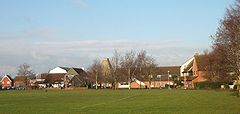Martlesham Heath
| Martlesham Heath | |
|---|---|
 Martlesham Heath village green and centre |
|
| Martlesham Heath shown within Suffolk | |
| OS grid reference | TM244453 |
| District | |
| Shire county | |
| Region | |
| Country | England |
| Sovereign state | United Kingdom |
| Post town | IPSWICH |
| Postcode district | IP5 |
| Dialling code | 01473 |
| Police | Suffolk |
| Fire | Suffolk |
| Ambulance | East of England |
| EU Parliament | East of England |
| UK Parliament | |
Martlesham Heath village is situated 6 miles east of Ipswich, in Suffolk, England. This was an ancient area of heathland and latterly the site of Martlesham Heath Airfield. A "new village" was established there in the mid-1970s and this has developed into a modern community, based on a traditional village pattern. The population is still included in that of Martlesham.
There is evidence of settlement in this area since the Bronze Age, with a number of round barrows surviving to the present. The main community of Martlesham grew up to the north-east, initially on the highest ground, where Martlesham Church is still located, then, later, centring on the point where the main London-to-Yarmouth road crosses the River Finn, a tributary to the Deben.
White's 1844 directory of Suffolk describes Martlesham as "a neat village near the confluence of a rivulet with the Deben" but mentions that the parish includes "a large, sandy, and unenclosed heath, extending about 2 miles S.W., and affording pasturage for numerous herds of sheep and cattle."
Up until 2013, the village held an annual festival, 'Village Day' latterly known as 'Music on the Green'. This event attracted hundreds of people each June with attractions such as live music fairground rides and Llama Jousting.
In 1917, the Experimental Aircraft Flight of the Central Flying School was transferred from Upavon, Wiltshire to a site on the heathland at Martlesham and, on 16 January 1917, Martlesham Heath Airfield was officially opened, as an experimental airfield. The unit was renamed the "Aeroplane Experimental Unit, Royal Flying Corps". After the end of World War I the site continued to be used and was, once again, renamed as the Aeroplane and Armament Experimental Establishment (A&AEE) of the Royal Air Force.
...
Wikipedia

